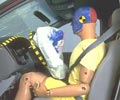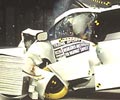 |
 |
 |
|
|
Convertible child safety
seats (seats that rear-face and forward-face, generally from 5 lbs to 40
lbs) have one of three types of harness systems:
Expert Statements on
harness types American Academy of Pediatrics: If using a convertible seat for a small infant, the best choice for a more secure fit is the 5-point harness. A shield could contact a small baby's face directly in a crash. National Highway Traffic Safety Administration (NHTSA): Shields are not recommended for newborns. When selecting a convertible seat for a newborn, choose one without a t-shield or tray shield in front of the baby. The shield comes up too high on the newborn and may make proper adjustment of the harness difficult. SafetyBeltSafe USA: Convertible seats come with three harness styles: five-point, T-shield, or tray-shield. If a convertible seat is used from birth, it is important to choose one with a simple, five-point harness instead of a harness with an attached shield. The five-point harness can be adjusted to fit almost all sizes and shapes of children up to 40 pounds. A harness system with a shield is not appropriate for a baby, since the shield lies in front of the face or neck and holds the harness straps away from the baby's body. A 5-point harness has several advantages for child of any age or size. The straps are placed on the child's shoulders and low on the hips, so that crash forces are absorbed by the strongest parts of the child's body instead of the soft abdomen. If the child is husky, a T-shield may press on chubby thighs, while a tray-shield may squeeze the tummy. In smaller cars, it may be hard to remove the child if the tray-shield cannot be raised completely. Safety experts have concerns about CRs with shields. Tray shields usually are not covered with energy-absorbing padding to protect the head if it hits the shield. This contact is more likely with a shorter child and a loose harness. In a test series with a 12-month-size dummy, peak head acceleration was 35% higher for tray shield restraints than for 5-point harnesses. At least one child (19 lb) is known to have received a fatal head injury from contact with a tray shield. For T-shields, there is a concern that the throat of a small child may be injured from contact with the top of the shield during a crash. In the same series of crash tests, neck forces were 40% higher for T-shields than for 5-point harnesses, and the crotch load with T-shields was 2.7 times higher than with 5-points. Dr. Michael Sachs and Stephanie Tombrello ("Car Seat Safety: Buckling Up Isn't Always Enough"): There are four basic designs of internal harness systems that secure children in their safety seats. If the seat meets or exceeds all applicable U.S. Federal Motor Vehicle Safety Standards, then the type of harness chosen becomes a matter of personal preference, although most child passenger safety experts agree that the five-point harness generally provides the best protection for the widest range of children. Automotive Coalition for Traffic Safety, INC.: Some models have 5-point harness systems that secure at both shoulders, across the upper thighs and between the legs. Others use a harness/T-shield combination that attaches two shoulder straps to a "T" shaped padded tray or shield, which attaches between the legs. Still others use a harness/tray shield combination. Because of concerns that the harnesses may not keep the baby's upper body properly positioned and that the baby's head or face may contact the shield in a crash, the American Academy of Pediatrics (AAP) does not recommend child safety seats with tray shields for small children. Child Passenger Safety experts agree that the Five-Point Harness is the safest, because it provides the snuggest fit and is suitable for the widest range of children. Why use a five point harness? Five-point harnessed car seats offer a much snugger harness fit than a shielded seat. In all five-point harness seats, the straps come down over the shoulders and across the hips to fasten to the buckle that comes up between the legs. The harness sits snugly against the bony parts of the pelvis (the crotch and hip straps) and across the shoulders and rib cage (the shoulder straps). When a child moves forward in the seat, as they would in a crash, the properly tightened harness is already "holding" the child and it immediately restrains them, spreading the crash force out across the strong bones of the body. There is nothing to impact; nothing for the child to suddenly hit. The child does not move before loading the restraint. Tray-shield and t-shield seats simply cannot restrain a child as snugly as a five-point
harness. Current motor vehicle safety standards require a "lap restraint"
for all car seats. On tray- and t-shield seats, the shield acts as the lap portion of
the restraint. However, these shields do not fasten snugly across a child's
pelvis as a five-point harness does, and they do not adjust to the
contours of the child's body. This allows more forward and side to side
movement than a five-point harness does - both before and during a crash.
The tray-shield generally sits at chest level, several inches away from the child.
The t-shield is buckled in at a set distance from the child and sits at chest or
abdomen level.
The straps that go over the child's shoulder and between their legs
are either attached to the tray or top of the t-shield, attached to the rigid crotch buckle, or
attached to webbing that attaches to the tray. These designs can allow
the shoulder straps to be pulled away from the child's body. Any space between
the child's body and the shield allow the child to gain a great deal of momentum
before s/he is restrained. That restraint is not merely composed of soft harness
webbing that stretches to absorb crash force, but a hard, unyielding plastic bar
or hard molded rubber. The thin amount of padding material on that bar or the
imagined softness of the rubber is not going to make any difference or provide a
soft cushion in a 35 mph collision. The design of tray- and t-shield car seats depends on
the child impacting those shields - it's part of the restraint. In a crash, the
force of the collision will propel the child's body forward.
There's no way to determine which part of the child's body will impact the
tray or t. Maybe they'll be "close enough" to it that they only end up with
bruised ribs or a bumped nose. Maybe they won't be so close and they'll break
their jaw, break their ribs, or damage their spleen. ER and trauma nurses can
account for the numerous head, chest and abdominal injuries they've seen in
children who've "impacted" tray and t-shields at a high rate of speed. Why are shield seats for sale? Tray-shield and t-shield seats pass the required federal safety standards, just as five-point harness seats do, and they are perfectly legal to buy and sell. It must be understood that the federal safety standards are minimal - currently only a frontal crash test with a partially instrumented dummy is required. In addition, the crash test dummies that are used in these tests are not children. Where a child is soft and flexible, a dummy is more rigid. Where a child will move and squirm in a seat, a dummy stays in the same place. The difference between five-point harness seats and tray- and t-shield seats is that real world crash experience shows us that children in five-point harness seats have less potential for injury than those in tray- and t-shield seats. T-shield seats have been discontinued by all manufacturers; tray-shield seats are still widely available. Tray-shield seats continue to be popular sellers for two reasons:
There is one other way to look at this issue - a comparison. Car seats are similar to cars, in that they both have to meet federal safety standards to be sold. Both the Toyota Sienna and the Chevy Venture pass the government safety standards and allowed to be sold and driven today. However, they do not perform the same in a crash. The Toyota Sienna provides excellent protection for the occupant, just as a properly used five-point harness seat does. The Chevy Venture allows more potential injury, just as a tray-shield seat does..
Remember, no car seat is safest unless it fits your child, fits your car
correctly, and is used PROPERLY every time. If you are not willing
or able to use a five-point harness correctly, you child may be safer in a
properly used tray-shield car seat. |
Copyright
© CPSafety
All Rights Reserved







